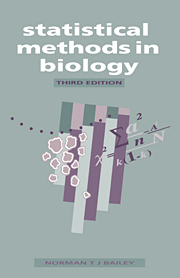Book contents
- Frontmatter
- Contents
- Preface
- 1 Introduction
- 2 Variability and frequency distributions
- 3 Estimation, standard errors and confidence limits
- 4 The basic idea of a significance test
- 5 Simple significance tests based on the normal distribution
- 6 The use of t-tests for small samples
- 7 Contingency tables and χ2
- 8 χ2-tests of goodness-of-fit and homogeneity
- 9 The correlation of measurements
- 10 Regression analysis
- 11 Simple experimental design and the analysis of variance
- 12 Introduction to factorial experiments
- 13 Random samples and random numbers
- 14 Partial correlation and multiple regression
- 15 Non-parametric and distribution-free tests
- 16 Notes on numerical calculation, calculators and computers
- Suggestions for more advanced reading
- Summary of statistical formulae
- Appendix tables
- Index
16 - Notes on numerical calculation, calculators and computers
Published online by Cambridge University Press: 05 June 2012
- Frontmatter
- Contents
- Preface
- 1 Introduction
- 2 Variability and frequency distributions
- 3 Estimation, standard errors and confidence limits
- 4 The basic idea of a significance test
- 5 Simple significance tests based on the normal distribution
- 6 The use of t-tests for small samples
- 7 Contingency tables and χ2
- 8 χ2-tests of goodness-of-fit and homogeneity
- 9 The correlation of measurements
- 10 Regression analysis
- 11 Simple experimental design and the analysis of variance
- 12 Introduction to factorial experiments
- 13 Random samples and random numbers
- 14 Partial correlation and multiple regression
- 15 Non-parametric and distribution-free tests
- 16 Notes on numerical calculation, calculators and computers
- Suggestions for more advanced reading
- Summary of statistical formulae
- Appendix tables
- Index
Summary
INTRODUCTION
It is proposed in this chapter to give a short account of some of the special points worth noting in connection with the fundamental business of carrying out basic statistical calculations, with regard to both the arithmetical aspects and the equipment required. There are many important details which can be easily overlooked by those who are mainly concerned in dealing with the more elementary work themselves, and who do not need to become involved in the niceties of advanced computation. Unless calculations are sufficiently accurate it is obvious that the statistical tests and analyses based on them may be completely vitiated. Nevertheless, one wants to avoid laborious complexities as far as possible. We shall therefore consider below some of the most important features to which special attention should be given, in particular, avoiding mistakes, achieving sufficient numerical accuracy, exhibiting the precision of statistical results, and choosing the most suitable level of automatic assistance, whether this be a simple or advanced pocket calculator, or a computer with specialised statistical software.
HOW TO AVOID MISTAKES
Before going on to look at computational details, we shall first consider some aspects of the general question of obtaining accurate calculations. It is very easy, even for those who are experienced in numerical work, to make small slips in reading or writing figures on a worksheet, in transferring numbers to or from a desk calculating machine or pocket calculator, in attaching plus and minus signs, or in interpreting brackets in algebraic formulae, etc.
Information
- Type
- Chapter
- Information
- Statistical Methods in Biology , pp. 190 - 202Publisher: Cambridge University PressPrint publication year: 1995
